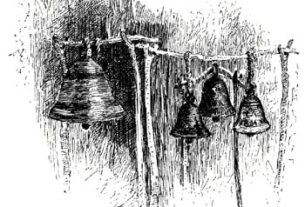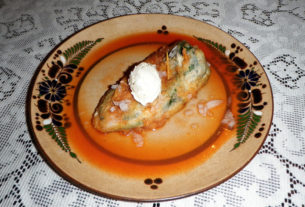Mexican Kitchen
Modern Mexican cooking is considered by culinary historians to be a fusion of three cuisines – indigenous, Spanish and French. This column has covered pre-Hispanic ingredients and techniques in the past, and last month focused on Mexican colonial-period cooking, characterized by the introduction of Spanish ingredients, notably animal products, citrus and other fruit, olives and olive oil, and Far Eastern spices, Spain’s culinary legacy from the Arab world. The next important element in the evolution of modern Mexican gastronomy is the influence of French cooking, one that began surprisingly earlier than is generally believed
Although culinary changes reached the New World slowly, continental cuisine was transformed from medieval – characterized by the heavy use of sugar and spices – to modern cuisine, in which the flavors are enhanced with salt and herbs, at about the turn of the seventeenth century. This style of cooking was dubbed nouvelle cuisine, a term which is actually over three hundred years old. However, it is evident from colonial Mexican kitchen manuals that, although many dishes were called a la francesca, they were still basically medieval.
It was in the early-to-mid 1800’s, several decades before Maximilian and Carlotta arrived to establish their ill-conceived empire, that Mexican cuisine began to be influenced by French recipes and techniques. In 1831, El Cocinero Mexicano (The Mexican Cook), the country’s first printed cookbook, was published by Mariano Galván Rivera.
The anonymous author of the book, which was to be the most influential Mexican cookbook of the 19th century, may very well have been more anti-Spanish than pro-French in his nationalistic approach to food (considering that this was written only a decade after independence from Spain) but nevertheless his treatment of recipes was in the tradition of classic French chefs. The importance of stocks, emphasized in El Cocinero Mexicano, is one of the foundations of French cuisine, as is the attention to digestion. (The author quotes Alexandre Dumas’ Dictionary of Cuisine on this topic.)
Although El Cocinero Mexicano and other cookbooks claimed to be nationalistic in their approaches to recipe collection, very few of them actually contained recipes for enchiladas, tamales and other corn-based dishes now considered to be quintessentially Mexican. Diccionario de Cocina, published in México City in 1845, calls tamales the food of the lower orders.
The formation of Mexican culture was still being seen in European terms, something that was to reverse itself a century later, but not before a period of intense effort on the part of the elite to emulate the architecture, fashion and cuisine of the French. The empire of Maximilian and the presidency of Porfirio Díaz were both influential in promoting la comida afrancescada (“Frenchified” cooking.)
When Maximilian and Carlotta began their doomed Mexican adventure, one of the first projects of the royal couple was the rebuilding of Chapultepec Castle, once the summer palace of the Spanish viceroys. Renovated in the Tuscan style, and decorated with furnishings from Queen Victoria and Czar Alexander II, the castle was the scene of one state dinner after another, where French cuisine was served. These meals began at 3:30 in the afternoon and lasted for five or six hours.
A menu dated March 29, 1865 is written in French, and one look at it explains why it took several hours to eat. Among the five courses are two soups, five fish and shellfish dishes, five meat dishes and assorted side dishes, desserts, champagne and French, Rhenish and Hungarian wines. Even at breakfast, sherry, bordeaux, burgundy and Hungarian wines were served. Historian Richard O’Connor, in writing of those days at the castle, tells us that “Creole society never gorged itself so completely and repeatedly as…when night after night the state dining room at Chapultepec was thrown open to feasting.” Among the dishes served at that March 29 meal was potage brunoise, the recipe for which calls for a bain marie, a cooking technique adopted by Mexican chefs and called a baño maria, used to make a jugo de carne very similar to the meat broth used in making potage brunoise. Another dish listed on the menu is vol-au-vent, the filled puff pastry shells that became the Mexican bolovanes. (The French influence on cakes and pastries alone could fill a book, and for an historical perspective on this, see The Pastry Wars, in the November 2003 issue of Mexico Connect.)
Despite the fine dining and drinking that went on at Chapultepec, Maximilian’s empire came to a tragic end, which possibly could have been predicted when, in a misguided attempt at gastronomic fusion, one of his Mexican guests on a canoe trip mixed pulque with French champagne, producing highly unpleasant effects on several of the drinkers on board. Two years later, Maximilian was accompanied on his last carriage ride toward the site of his execution by his faithful chef, Tudos.
During the thirty-five years that followed, under President Porfirio Díaz, a Francophile infatuated by European culture, French influences permeated Mexican cuisine. The terms and sauces used in French cooking, such as béchamel and velouté, became part of the Mexican culinary repertoire. Brillat-Savarin’s Psychology of Taste had been published in a Mexican edition in 1852, and in 1893 a cookbook by the chef of the Paris Jockey Club was published in Mexico. Housewives eagerly read the newspaper recipe pages in order to duplicate the characteristic dishes of fine French cuisine.
In Una Mirada Historica a través de la Comida – A Look at History through Food – Tonantzín Ortíz Rodríguez points out that while eating is a biological act, cooking is a cultural, social and economic act. Cuisine permits us to identify the group from which an individual comes. The culinary styles of the Porfiriato, divided so markedly between those of the elite and those of the poor, seem like a clear indication of the revolution to come.
Homemakers such as Lucía Cabrera de Azcárate, whose manuscript cookbook of 1901, Recetario de Tepetitlán, Puebla , has recently been published by CONACULTA, the National Council for Arts and Culture, were clearly from a social class that could adopt the French recipes and techniques. The book contains several French reduced sauces that the señora prepared at home, as well as complicated sweets and desserts and an array of nearly every type of meat, fish and game imaginable.
Although the French influence on Mexican cooking was subsequently downplayed in favor of a more nationalistic approach, French techniques and Mexican ingredients made an excellent gastronomic pairing. Native ingredients such as squash blossoms, huitlacoche and avocados took beautifully to French style soups, crepes and mousses. Although these are claimed by proponents of the current nouvelle cuisine, they are offshoots of the French-Mexican culinary blending of the nineteenth century.
The following recipes, while containing many indigenous Mexican ingredients, would never have come to be created without the techniques learned from the French.


